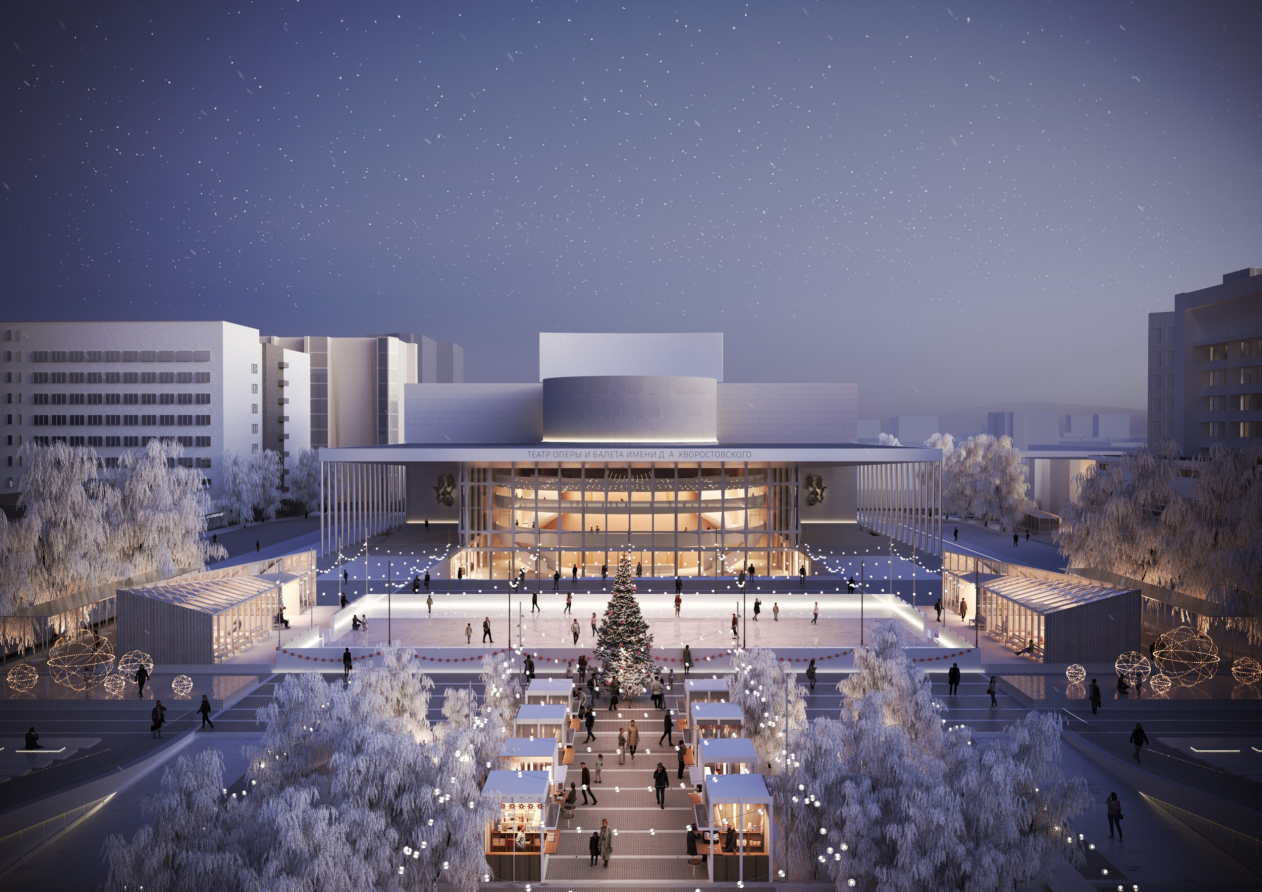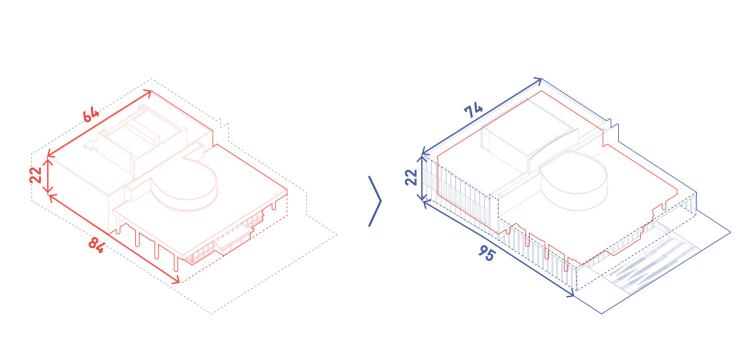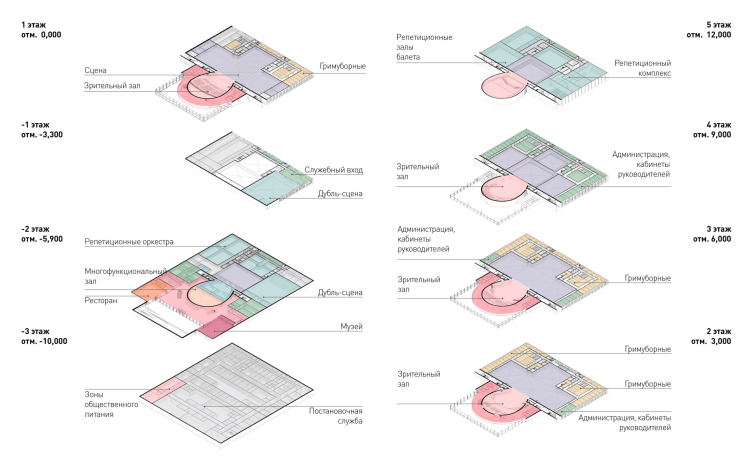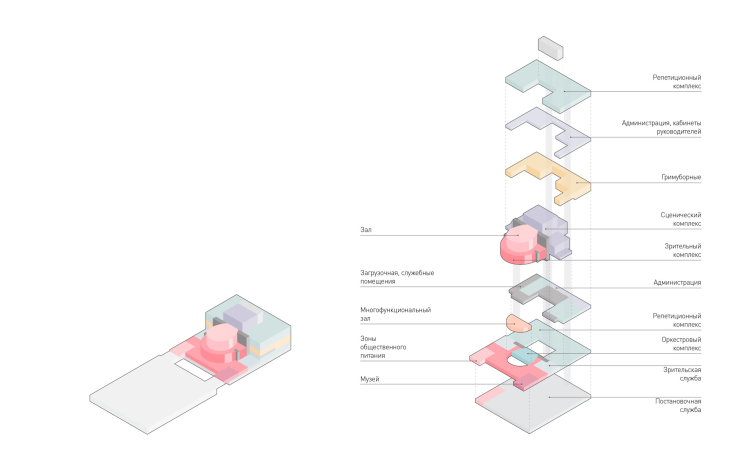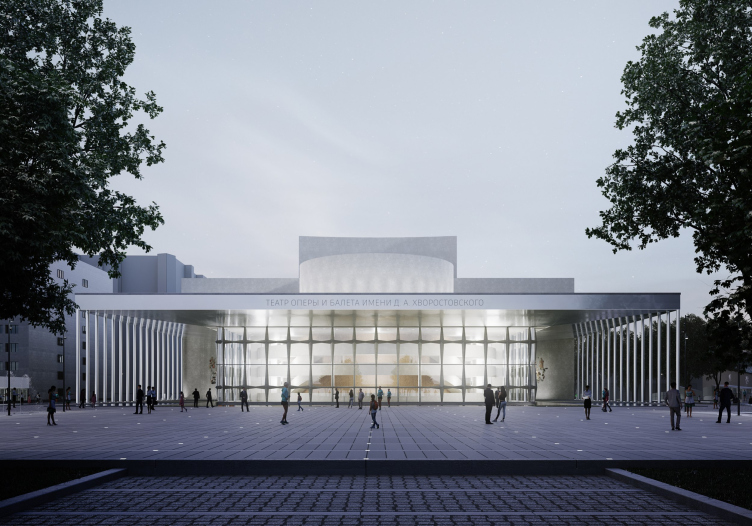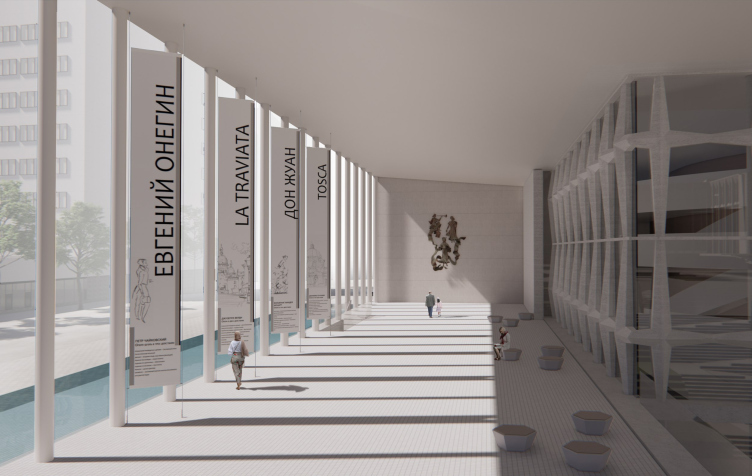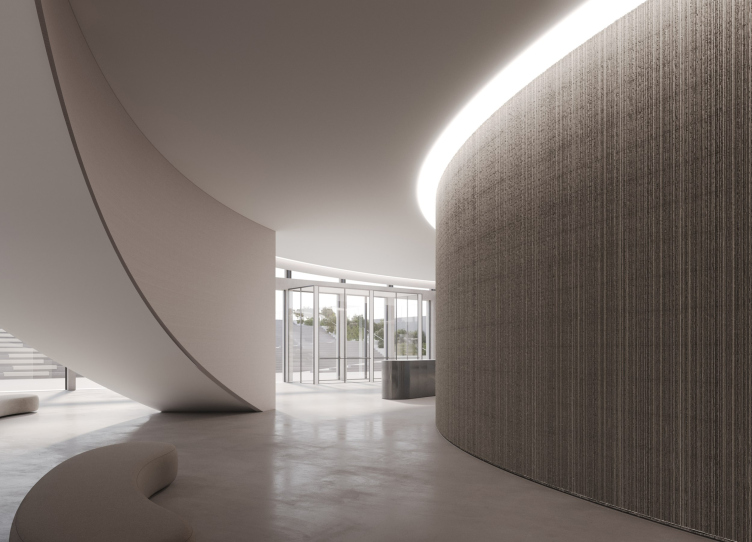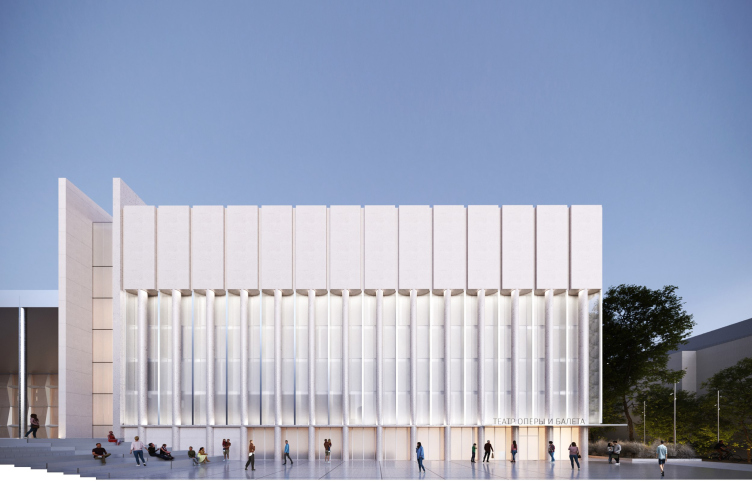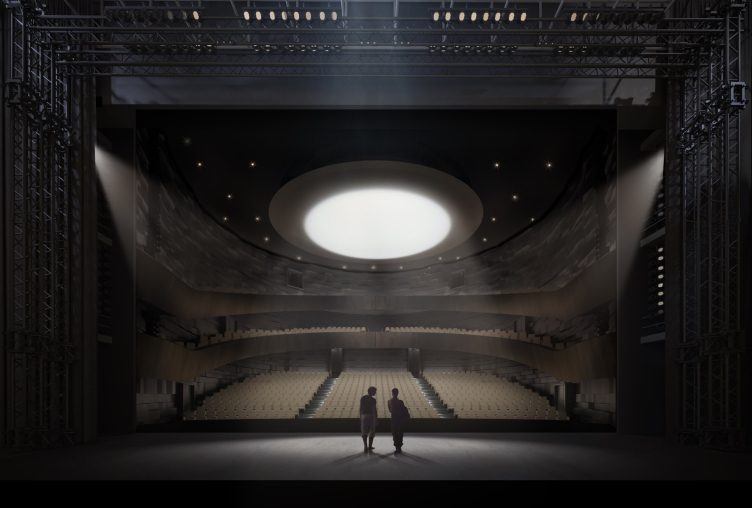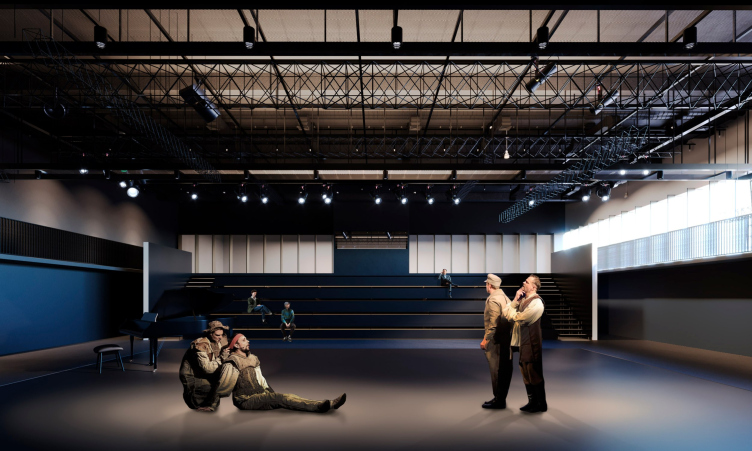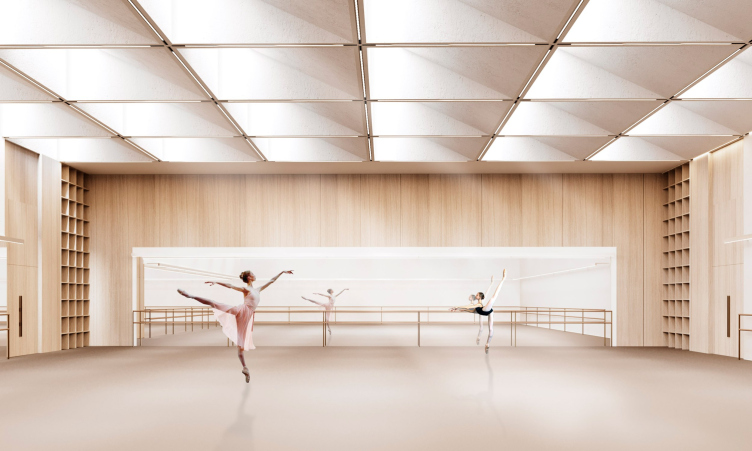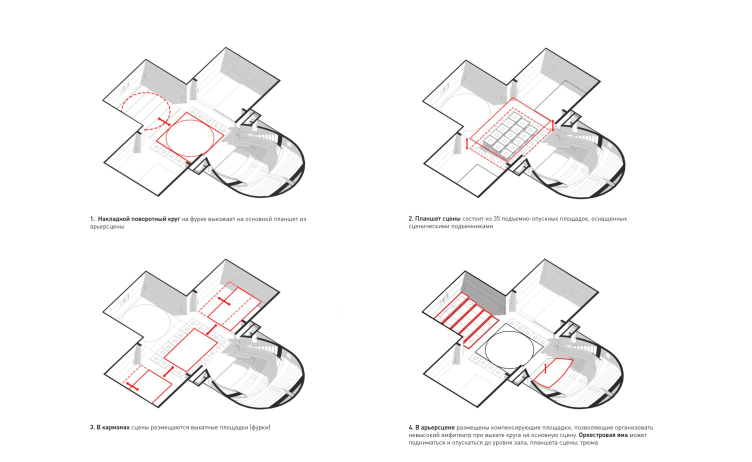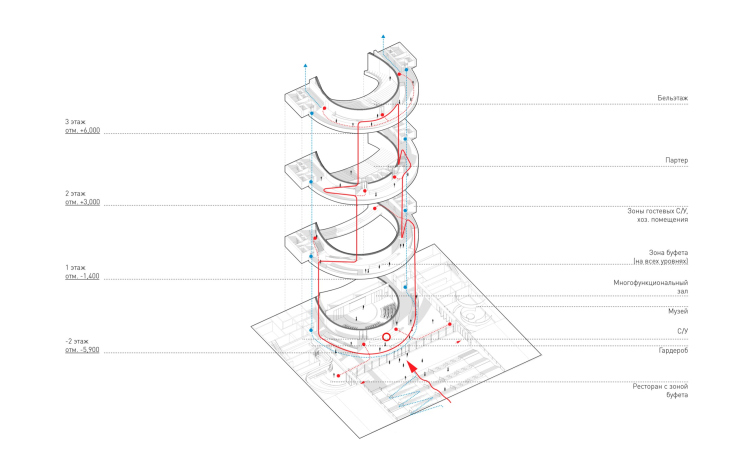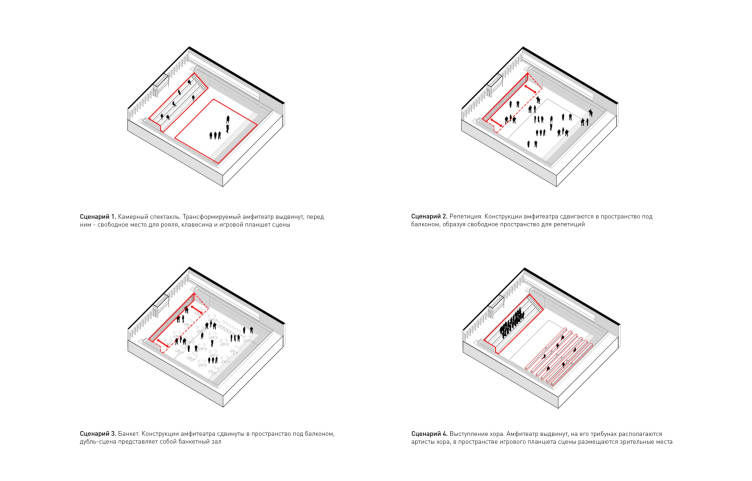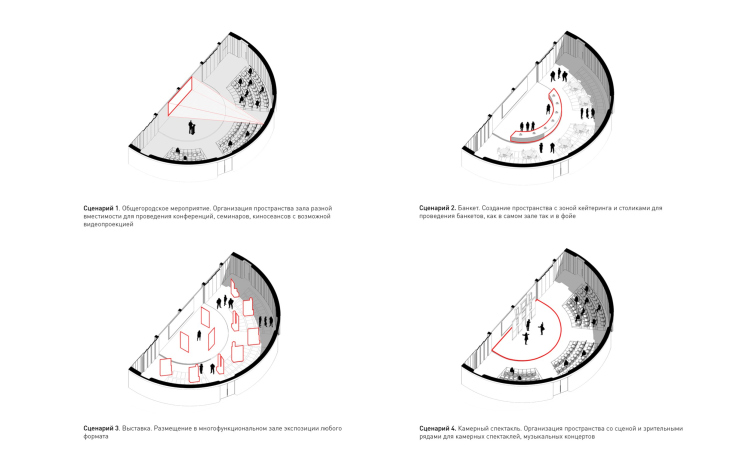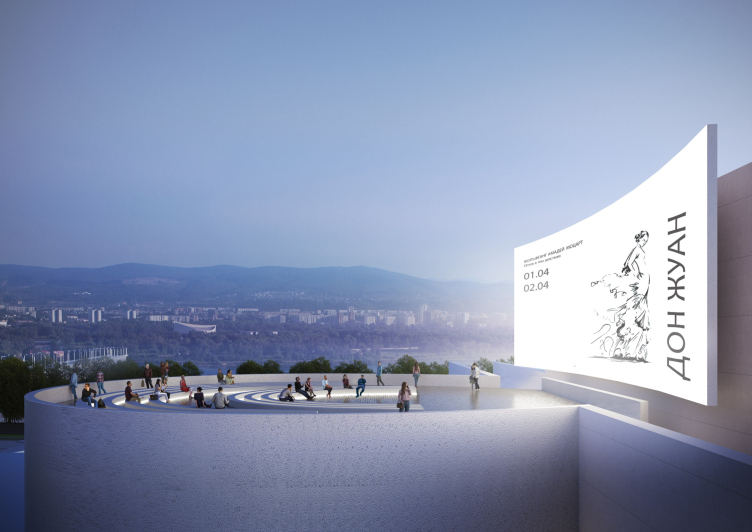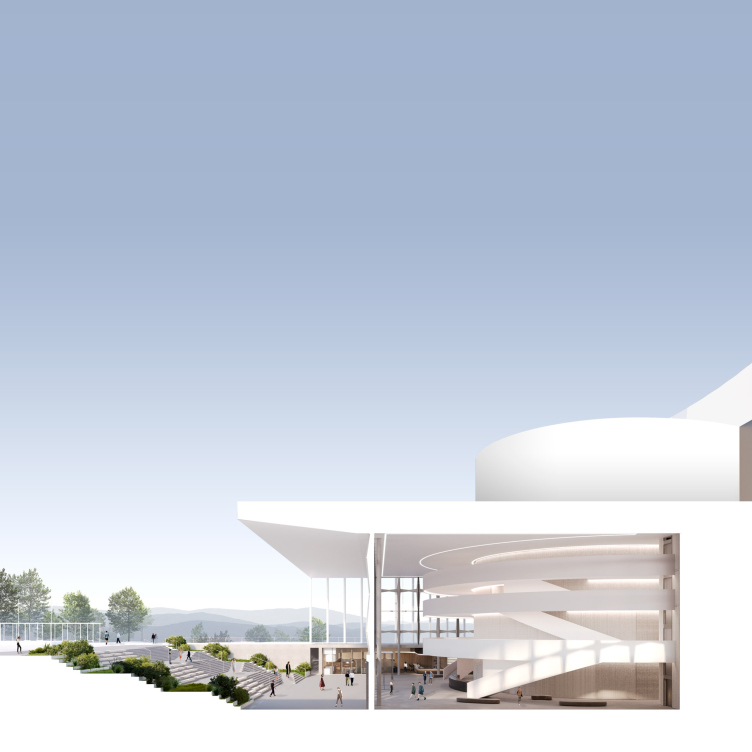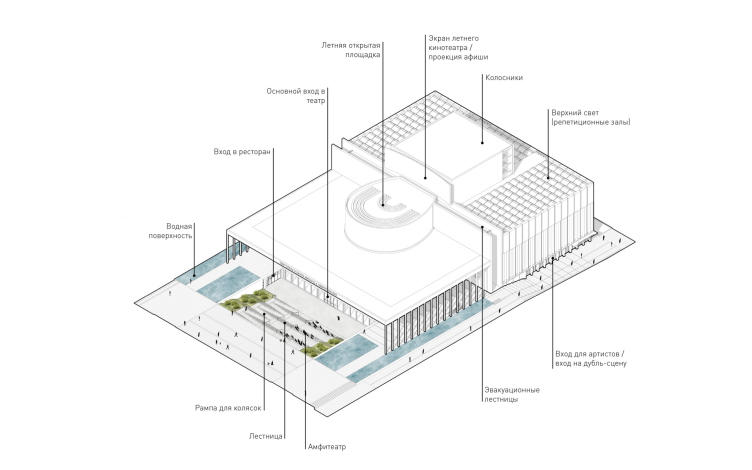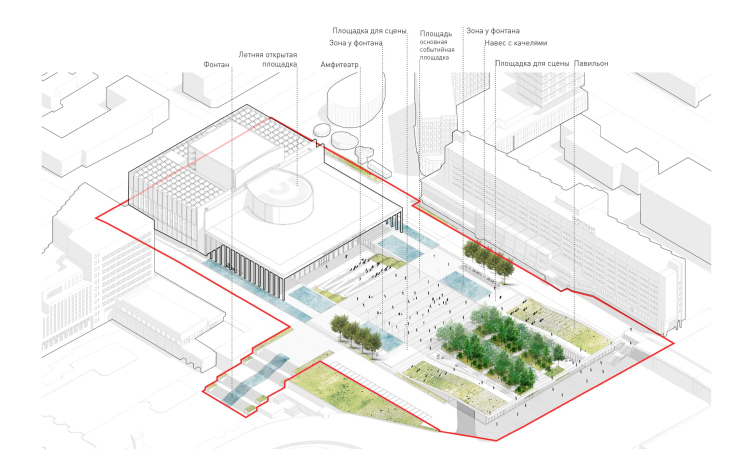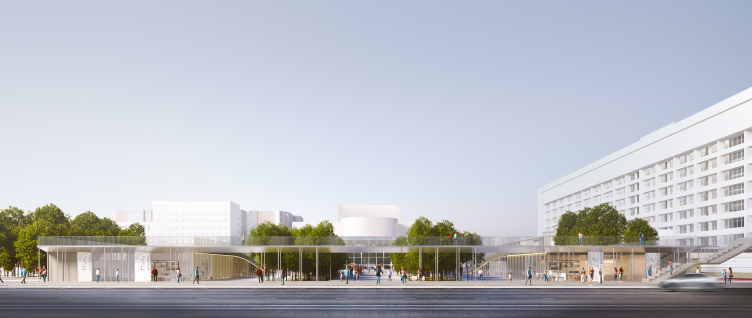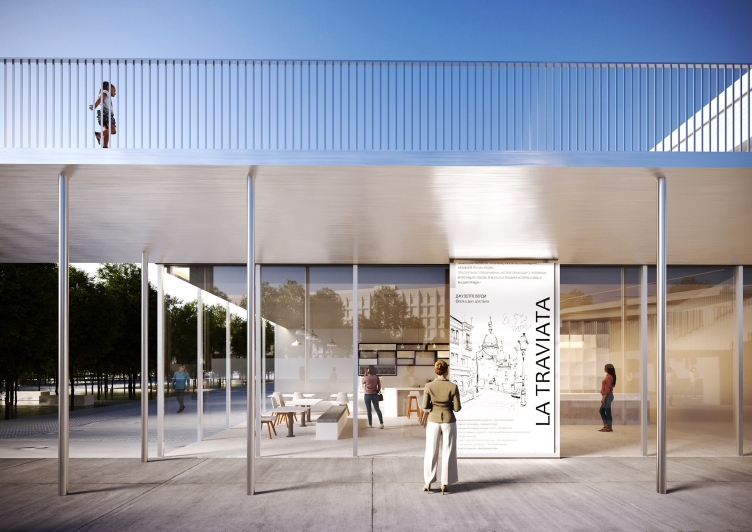The theater was built in 1966-1978 upon the project by Ivan Mikhalev, and, curiously, he designed it specifically as a music theater before it was ever completed, it was turned into an “opera and ballet theater”, which, according to its current director Svetlana Guziy, presupposes a staff twice as large. This effectively means that the troupe would have found themselves in close quarters by default. Over the recent decades, as the requirements for the theatrical art grew stricter, the space became even more cramped. Accordingly, the reconstruction, designed and supported by the Nornickel company, provides for a considerable expansion, but the brief specifically stipulated the necessity for keeping up the image of the old theater and the square in front of it: “The theater square must come to our descendants in the state it was devised 45 years ago”.
Concept of reconstruction of the Krasnoyarsk State Opera and Ballet Theater named after D.A. Khvorostovsky
Copyright: © WOWHAUS
The concept by Wowhaus includes demolition and new construction: on the plan, the building is expanded 11 meters length-wise and 10 meters width-wise. The height remains the same, but the building gets underground floors – below the zero elevation, the architects are placing a restaurant, a foyer, and a museum, about which – the authors emphasize – the theater has long since dreamed. The new theater building will have a total of 8 levels, which will make it possible to include everything you need, including dressing rooms on all the three floors, rehearsal halls, a duplicate stage for dress rehearsals and small-stage performances, and a hall for the children’s theater studio.
Concept of reconstruction of the Krasnoyarsk State Opera and Ballet Theater named after D.A. Khvorostovsky. The change of dimensions
Copyright: © WOWHAUS
Concept of reconstruction of the Krasnoyarsk State Opera and Ballet Theater named after D.A. Khvorostovsky. Plans
Copyright: © WOWHAUS
Concept of reconstruction of the Krasnoyarsk State Opera and Ballet Theater named after D.A. Khvorostovsky. The functional zoning
Copyright: © WOWHAUS
Despite the fact that the new building is built from scratch [UPD 21.06.223: in the project, the architects retain the grand auditorium, the stage, and its pockets], the architects liken it to the old one as part of the image retention. For example, in the project the volume is also composed of two parallelepipeds with the upper projection of the columns; the architects reproduce the star-cross-shaped “cosmic” pattern of the concrete lattice of the stained glass window, the horseshoe-shaped volume of the hall, sculpturally protruding from outside, and even the colonnades on the sides – only with increasing scale the columns lose their solidity and turn into a series of thin supports; the pauses between them and the center increase. Even the inscription on the frieze is similar, although, obeying the new scale, it too has become smaller and thinner. Everything is similar, but different, and, executed in modern materials, looks recognizably unrecognizable. Maybe this approach even better embodies the idea, which was in the 1960s limited by the material base, even though you never can tell. A similar experiment to turn a 1950s building into a larger one was carried out by UNK architects in their work on the Palace of Water Sports, which replaced the Luzhniki swimming pool. What we are seeing is an enlarged paraphrase, but not a copy.
The architects save – in the original material – two sculptural groups of the “Muses”, carrying them over from the central location to the sides of the main entrance, i.e. to the side ends of the galleries.
Concept of reconstruction of the Krasnoyarsk State Opera and Ballet Theater named after D.A. Khvorostovsky
Copyright: © WOWHAUS
The “Muses” sculpture is moved from the facade to the side ends of the gallery. Concept of reconstruction of the Krasnoyarsk State Opera and Ballet Theater named after D.A. Khvorostovsky
Copyright: © WOWHAUS
It’s a rather curious experience watching how one turns into the other. In the new project, the following happens: the entrance group disappears or becomes all but invisible (how does it look on the 3D renders, I wonder?); and this entrance group cuts significantly into the starry stained-glass window of the original building. [UPD 21.06.2023: according to the architects, the entrance group was rebuilt many times, and the one that exists now does not refer to the original project]. At the same time, what appears behind the glass is a whirl of the spectator area and balconies, from which one will be able to get to different stage levels – looks a bit like Wright’s Guggenheim – it continues the “horseshoe” volume of the amphitheater, situated higher up: now, the parallelepiped has not just one volume inserted into it, but two.
Concept of reconstruction of the Krasnoyarsk State Opera and Ballet Theater named after D.A. Khvorostovsky
Copyright: © WOWHAUS
The theater now:
Now in the existing building the columns line the sides of the eastern volume of the foyer, while the western “stage” volume is designed laconically, like a crate. In the project, the foyer’s colonnades become, as we remember, more delicate and thin, and in the western part they also receive a continuation – in the form of tie rods inserted into the ledges of large grooves; the wall receives a meaningful relief, which was not present in the original building, it brings a note of Art Deco in the context of its basically modernist project (which quite suddenly echoes the Palace of Water Sports, where, however, the Art Deco component is original). At the junction of the two volumes evacuation stairs are situated – here there is a narrow transverse “layer”, sandwiched between the walls.
The decorative colonnade of the side volume. Concept of reconstruction of the Krasnoyarsk State Opera and Ballet Theater named after D.A. Khvorostovsky
Copyright: © WOWHAUS
The sidewall now:
The new scale, the new fragility and thinness of the building, which inherits the ideas of the modernist theater, but not its proportions, receives a contrasting response in the image of the main hall: it is clearly inspired by the memory of one of the main landmarks of the region, the extinct volcano “Black Mountain” – the audience, figuratively of course, but judging by the pictures, still quite tangibly, is placed “inside” a black volcano with a rounded, rough and dark wall surface: the image rhymes well with the acoustic panels. The glowing circle of the main chandelier is likened to the vent of the volcano, at which we are looking, therefore, from within. On the whole, it is obvious that the blackness of the new hall, convenient for performances, becomes a contrast to the light whiteness of the facades and foyer.
Concept of reconstruction of the Krasnoyarsk State Opera and Ballet Theater named after D.A. Khvorostovsky
Copyright: © WOWHAUS
The minor hall and the duplicating halls will be designed in a slightly simpler way because you can’t peddle the idea of the “core” everywhere, and the rehearsal halls will be even lighter.
Concept of reconstruction of the Krasnoyarsk State Opera and Ballet Theater named after D.A. Khvorostovsky
Copyright: © WOWHAUS
Concept of reconstruction of the Krasnoyarsk State Opera and Ballet Theater named after D.A. Khvorostovsky
Copyright: © WOWHAUS
The main stage is equipped with mechanisms and is designed to be transformed. It is planned in a cross shape, like an Egyptian “Ankh” symbol, with the auditorium “loop” at the base. In the center; there are 35 sliding cubic podiums; from the rear stage at the top of the cross, the turntable can be moved out, and when it moves out it creates the possibility to build an additional “rear” amphitheater behind the rear stage, seating the audience on both sides of the stage. Several more mobile platforms are parked in the side wings, and the orchestra pit can be elevated to three different levels.
The grand auditorium: the cross-sectio view and axonometry. Concept of reconstruction of the Krasnoyarsk State Opera and Ballet Theater named after D.A. Khvorostovsky
Copyright: © WOWHAUS
The grand auditorium: the transformations. Concept of reconstruction of the Krasnoyarsk State Opera and Ballet Theater named after D.A. Khvorostovsky
Copyright: © WOWHAUS
The tiers of the public areas around the grand auditorium. Concept of reconstruction of the Krasnoyarsk State Opera and Ballet Theater named after D.A. Khvorostovsky
Copyright: © WOWHAUS
An additional stage is located in the northern part, to the right, and occupies the -1 and -2 floors. Its rectangular space is transformable thanks to a collapsible amphitheater. The other multi-purpose hall is semi-circular, situated directly under the main stage; here the multi-functionality is ensured by different variants of furniture arrangement.
Concept of reconstruction of the Krasnoyarsk State Opera and Ballet Theater named after D.A. Khvorostovsky. Transformations of the duplicating stage
Copyright: © WOWHAUS
Concept of reconstruction of the Krasnoyarsk State Opera and Ballet Theater named after D.A. Khvorostovsky. Transformations of the multifunctional auditorium
Copyright: © WOWHAUS
One of the important features of the project is the highly developed system of public spaces, both around the theater and on the roof of the auditorium. Additional performances and film screenings are also possible on the roof, and in front of the entrance to the foyer under a large canopy.
The venue on the roof of the grand auditorium. Concept of reconstruction of the Krasnoyarsk State Opera and Ballet Theater named after D.A. Khvorostovsky. Transformations of the duplicating stage
Copyright: © WOWHAUS
The foyer entrance, a cross-section view. Concept of reconstruction of the Krasnoyarsk State Opera and Ballet Theater named after D.A. Khvorostovsky. Transformations of the duplicating stage
Copyright: © WOWHAUS
Concept of reconstruction of the Krasnoyarsk State Opera and Ballet Theater named after D.A. Khvorostovsky. Transformations of the duplicating stage
Copyright: © WOWHAUS
The architects completely revise the square in front of the theater: it is already big as it is, 140 meters long; it has three fountains on it, a sculpture of Apollo, a couple of lions at the entrance, a certain quantity of trees on the perimeter, but otherwise the square is empty.
This square gets a lot of attention in the project. The square is multilevel: first, already now in its southern part, to the left and closer to the Yenisei river, where the height difference is from 4 to 5 meters, there is a four-level cascading staircase – the architects use it, preserving the fountain in the middle. Second, the area in front of the entrance is deepened and is accessed by a green city amphitheater with a zigzag-shaped ramp – Wowhaus already designed and built a similar one at the eastern entrance to Moscow’s Gorky Park; as a matter of fact, the amphitheater will make it possible to organize open-air performances.
Concept of reconstruction of the Krasnoyarsk State Opera and Ballet Theater named after D.A. Khvorostovsky
Copyright: © WOWHAUS
Finally, on the sides of the square closer to Weinbaum Street, the architects propose two pavilions with terraced roofs, which also descend by steps toward the theater – so it turns out that all the surfaces consistently build up toward the city and descend to the entrance of the theater.
Concept of reconstruction of the Krasnoyarsk State Opera and Ballet Theater named after D.A. Khvorostovsky. The formation of the square
Copyright: © WOWHAUS
Concept of reconstruction of the Krasnoyarsk State Opera and Ballet Theater named after D.A. Khvorostovsky. The summer scenario
Copyright: © WOWHAUS
Concept of reconstruction of the Krasnoyarsk State Opera and Ballet Theater named after D.A. Khvorostovsky. The winter scenario
Copyright: © WOWHAUS
In addition, quite a lot of water is provided, a dry fountain, a cascade, ponds, as well as a winter scenario of using the square as an ice rink.
The pavilions are united with a canopy on thin metal supports – this peculiar standing portico marks the border of the square and somewhat levels the protrusions of the ends; besides, it reminds of the same entrance to Gorky Park from Leninsky Prospekt in Moscow.
Concept of reconstruction of the Krasnoyarsk State Opera and Ballet Theater named after D.A. Khvorostovsky
Copyright: © WOWHAUS
Concept of reconstruction of the Krasnoyarsk State Opera and Ballet Theater named after D.A. Khvorostovsky
Copyright: © WOWHAUS
As we can see, the project has the trademark Wowhaus style, and it is made according to the rules of modern theater buildings: grand-scale, transformable, and multifunctional. The task of turning the space around the theater and inside of it into a point of attraction for the urban community has been solved here at different levels and with the expectation for different audiences.
Some doubt is caused by the fact that the building becomes an elegant but still replica of the former theater, that is, it sort of freezes halfway, provoking the question: what do you ultimately need, the old building or the new one?
***
The judging panel of the competition:
Konstantin Shumov, Honorary Architect of the Russian Federation, Head of the Krasnoyarsk Krai Urban Planning Control Service; Chief Architect of the Krasnoyarsk Krai, Chairman of the Judging Panel
Arkady Zinov, Honored Artist of the Russian Federation, Minister of Culture of the Krasnoyarsk region, Deputy Chairman of the Judging Panel
Dmitry Bertman, General Director; Artistic Director of the Moscow Musical Theater Helikon Opera
Andrey Bokov, People’s Architect of the Russian Federation, Honorary President of the Union of Architects of Russia, Vice-President of the International Academy of Architecture, President of the Moscow branch of the International Academy of Architecture, Member of the Russian Academy of Architecture and Building Sciences, Corresponding Member of the Russian Academy of Arts
Andrey Borisov, Director of the Moscow Stanislavsky and Nemirovich-Danchenko Academic Musical Theater
Sergey Geraschenko, Honorary Architect of the Russian Federation, Professor of the Department of Urban Planning at the Institute of Architecture and Design of Siberian Federal University
Sergey Gnedovsky, People’s Architect of the Russian Federation, Vice-President of the Union of Architects of Russia, Academician of the Russian Academy of Architecture and Building Sciences
Elena Grigorieva, honored architect of the Russian Federation, vice president of the Union of Architects of Russia, member of the International Academy of Architecture, corresponding member of the Russian Academy of Architecture and Construction Sciences, editor-in-chief of Project Baikal
Svetlana Guziy, Director of the D.A. Khvorostovsky Krasnoyarsk State Theater of Opera and Ballet
Georgy Isaakyan, Artistic Director of the Natalia Satz Moscow State Academic Children’s Musical Theater, Laureate of the State Prizes of the Russian Federation, Laureate of the President Prize of the Russian Federation, Honored Art Worker of the Russian Federation, Professor
Irina Korobina, professor of the Moscow Architectural Institute (State Academy), PhD in architecture, member of the International Academy of Architecture, member of the National Academy of Design, honorary member of the Russian Academy of Arts
Vladislav Loginov, Head of Krasnoyarsk
Yuri Oleynikov, Advisor to the Vice President of MMC Norilsk Nickel
Mikhail Rabushko, Minister of Construction of the Krasnoyarsk Territory

